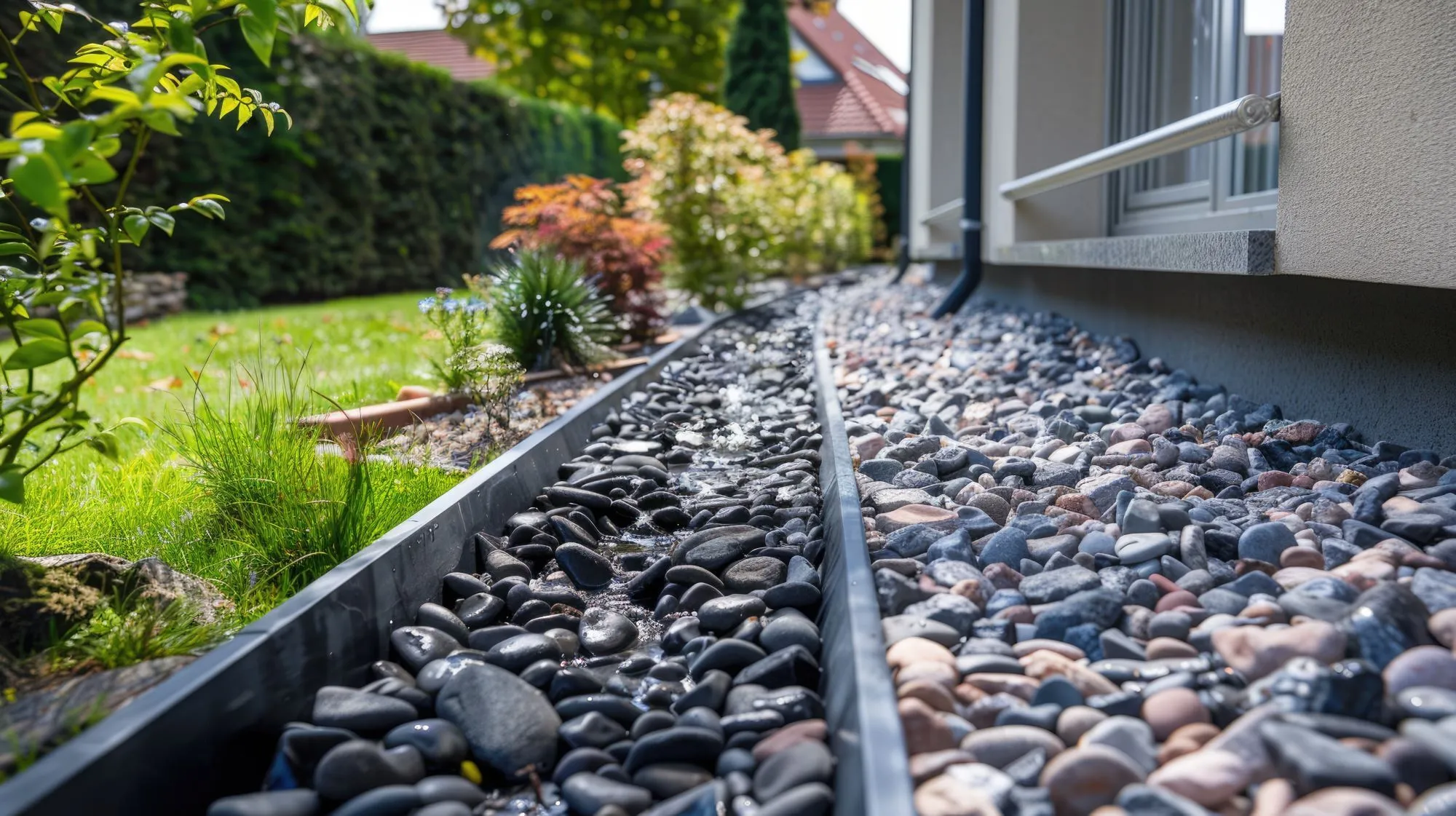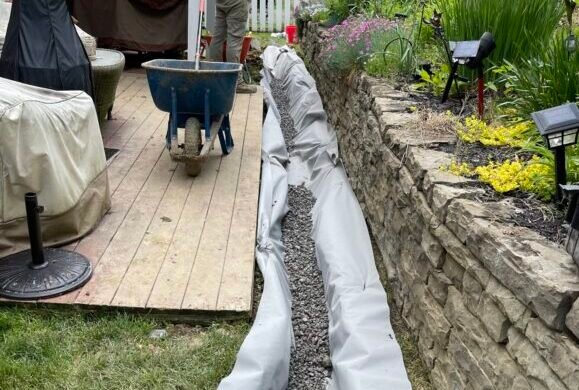A French drain is a simple yet effective solution to manage excess water around your property. It’s essentially a sloped trench filled with gravel and a perforated pipe that helps redirect water away from areas prone to flooding or pooling. If soggy lawns or waterlogged basements are causing you headaches, a French drain might be just what you need. At Evergreen Landscaping of Cincinnati, we specialize in installing French drains to protect your home and yard from water damage. Let us help you keep your outdoor spaces beautiful and functional with this smart drainage solution.
What is a French Drain?

At its core, a French drain is a trench filled with gravel or rock that contains a perforated pipe. Its purpose is to redirect surface water or groundwater away from your home, yard, or other areas prone to flooding. Think of it as a channel that collects water and sends it somewhere safer.
The design of a French drain is simple but highly effective. By creating a path of least resistance for water, it prevents pooling in unwanted areas. This drainage system can be installed in residential, commercial, and agricultural settings—pretty much anywhere water needs to be managed.
How Does a French Drain Work?
A French drain works by redirecting excess water through a perforated pipe buried in a trench filled with gravel or rock. The perforations allow water to enter the pipe, which then carries it away from the area, preventing water buildup that could damage foundations or cause flooding. Drainage Solutions Services can install and maintain French drains to ensure effective water management around your property, safeguarding your home from moisture damage, erosion, and pooling water while enhancing soil stability.
Here’s how a French drain functions:
Collection of Water: The trench is strategically placed in areas where water tends to accumulate. Water naturally flows downhill, so the slope of the drain helps guide the water toward the desired exit point.
Gravel Layer: The trench is lined with gravel, which helps filter debris and allows water to flow more freely toward the pipe.
Perforated Pipe: A perforated pipe is placed at the bottom of the trench. This pipe has small holes or slits that allow water to enter while keeping out large debris.
Drainage Path: The pipe directs the collected water to a safe discharge point, such as a storm drain, dry well, or a lower-lying area on your property.
Covering: Once the pipe is in place, the trench is filled with more gravel and sometimes covered with fabric or turf for aesthetic purposes.
Common Uses of French Drains
Common uses of French drains include preventing water damage around foundations, redirecting water away from basements, and managing yard drainage to prevent flooding. They are often used in areas with poor natural drainage, like clay soils. For residential properties in Liberty Township, the best drainage systems include French drains, surface drains, and channel drains, which efficiently direct water away from homes. These systems protect foundations, basements, and landscaping, ensuring water is managed effectively, reducing the risk of erosion and water damage.
French drains are incredibly versatile and can address a variety of water-related issues, including:
Preventing Basement Flooding: Installing a French drain around your home’s foundation helps keep water from seeping into your basement.
Yard Drainage: If your lawn turns into a swamp after heavy rains, a French drain can redirect the water to a more suitable location.
Protecting Retaining Walls: Water pressure can weaken retaining walls over time. A French drain installed behind the wall helps relieve that pressure.
Redirecting Downspout Runoff: Excess water from gutters and downspouts can cause erosion or pooling. A French drain can guide that water away safely.
Benefits of a French Drain
Effective Water Management: French drains provide a reliable way to redirect water, reducing the risk of flooding and erosion.
Low Maintenance: Once installed, a French drain requires minimal upkeep. Occasional checks for clogs or damage are usually enough.
Cost-Effective: Compared to other drainage solutions, French drains are relatively affordable and easy to install.
Versatility: They work for both small residential properties and large commercial sites.
Aesthetic Appeal: When covered with grass or decorative stones, a French drain blends seamlessly into your landscape.
Installing a French Drain

Installing a French drain involves digging a trench, laying a perforated pipe, and covering it with gravel or rock to ensure water can flow freely. The pipe is sloped to direct water away from problem areas. What maintenance tasks are involved in keeping a drainage system working properly? Maintenance tasks include clearing debris from the drain’s openings, ensuring the trench remains free from sediment buildup, and checking the pipe for blockages. Additionally, it’s important to periodically inspect the surrounding landscape to ensure proper water flow and address any issues before they cause damage.
If you’re considering a French drain for your property, here’s what the installation process typically looks like:
Assess the Problem Area: Identify where water is pooling or causing damage. The drain needs to be placed in a location where it can effectively intercept and redirect water.
Plan the Layout: Determine the best route for the trench. The drain must have a consistent slope (usually about 1 inch per 8 feet) to ensure proper water flow.
Dig the Trench: Using a shovel or trencher, dig a trench that’s deep and wide enough to accommodate the pipe and gravel.
Line with Fabric: Landscape fabric is often used to prevent soil and debris from clogging the gravel and pipe.
Add Gravel and Pipe: Place a layer of gravel at the bottom of the trench, followed by the perforated pipe. Ensure the pipe’s holes face downward to collect water effectively.
Cover with Gravel: Add more gravel to cover the pipe, leaving room to top it off with soil or decorative stones.
Test the System: Before finishing, test the drain by running water through it to ensure it flows as intended.
Finish with Landscaping: Cover the trench with soil, sod, or other landscaping materials to make it blend into your yard.
Maintenance Tips for French Drains
While French drains are relatively low-maintenance, here are some tips to keep them functioning properly:
Check for Clogs: Over time, debris can accumulate and block the pipe. Regularly inspect the drain and remove any obstructions.
Monitor Water Flow: After heavy rains, observe how well the drain is working. If you notice pooling, it may need cleaning or repair.
Replace Damaged Components: Crushed pipes or eroded gravel can compromise the system. Replace any damaged parts promptly.
Keep the Area Clean: Avoid planting trees or shrubs too close to the drain, as roots can invade and block the pipe.
DIY vs. Professional Installation
Installing a French drain can be a DIY project if you have the right tools and a basic understanding of drainage systems. However, larger or more complex projects might require professional help. Hiring an experienced contractor ensures proper design and installation, especially for drains near foundations or in areas with challenging soil conditions.
When to Call a Professional
If you’re unsure whether a French drain is right for your situation, consulting a professional can save you time and effort. They can assess your property’s needs and recommend the best drainage solution. Complex installations, like those involving steep slopes or proximity to structures, are best left to the experts.
FAQs
What are the disadvantages of a French drain?
1. French drains can clog over time if debris or sediment enters the perforated pipe or gravel, requiring regular maintenance or repairs.
2. Installation can be labor-intensive and costly, especially for larger systems or areas with challenging terrain.
3. They may not work effectively in properties with poor soil drainage, such as heavy clay, which limits water flow.
Where does water from a French drain go?
1. Water from a French drain is typically directed to a safe discharge point, such as a storm drain or a dry well.
2. It can also be routed to a lower-lying area on your property where water can naturally disperse.
3. In some cases, water may be redirected to a drainage ditch or a municipal sewer system, depending on local regulations.
What is the purpose of a French drain?
A French drain is a drainage system designed to redirect excess water away from an area, typically preventing flooding and soil erosion. It consists of a trench filled with gravel or rock and a perforated pipe that allows water to flow through and be carried away. This system is often used around foundations, basements, or in yards to manage surface water or groundwater.
How deep does a French drain need to be?
The depth of a French drain typically ranges from 6 inches to 3 feet, depending on the specific drainage needs and the area’s water flow. For residential applications, a depth of 18 to 24 inches is common to ensure effective water collection and diversion. The drain should also have a slight slope (around 1-2%) to encourage water flow toward the desired exit point.
Where not to put a French drain?
A French drain should not be placed in areas with poor soil drainage, such as clay-heavy soils, as it can become ineffective over time. Avoid installing it near utility lines or septic systems, as the excavation could damage them. Additionally, do not place it in areas with heavy tree root growth, as roots can clog the drain and disrupt its function.
Final Thoughts
A French drain is an efficient and practical way to tackle water drainage issues. Whether you’re dealing with a soggy yard, a leaky basement, or water damage, this system can provide long-lasting relief. With proper planning and installation, a French drain will protect your property and enhance your outdoor spaces for years to come.
Got drainage problems? Don’t wait until water wreaks havoc on your property. Consider installing a French drain today and enjoy a drier, safer, and more beautiful landscape.
